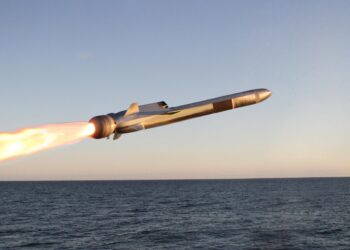US Navy, “We’ve needed something like this since Desert Storm,” said Capt. Curtis Whalen, Operations Officer of Naval Coastal Warfare Group One in San Diego, about the Anti-Swimmer Grenade (ASG), a weapon currently being enhanced by the Safe-Arm Development Branch at China Lake. He said that, while the average person doesn’t hear much about it, enemy or terrorist swimmers have been a threat to naval and commercial ships going as far back as the Vietnam War. Well-placed explosives on the hulls of ships can severely damage, and even sink, large vessels.
The MK3A2 concussion grenade, which is very effective against enemy soldiers in bunkers, buildings, and underground passages, is the main weapon used against swimmers by the Navy and Coast Guard. “These grenades are meant for use in rooms or on the battlefield, not for under water,” said Whalen, “but it’s the best thing we’ve had available.” And now, he says, the MK3A2 is no longer in production and is being phased out.
NAVSEA’s Program Executive Office for Integrated Weapon Systems has been looking for a replacement of the MK3A2, and after seeing a presentation sent to him by ASG Project Lead Walter Maurer, the NCWG1 ops officer said the ASG “looks like the best replacement option so far.”
ASG began as a grassroots effort in 2000. The Fuze and Warhead Division had learned of the need for a more effective anti-swimmer device and had started an exploratory project in 2001 with discretionary funds. Initial phases of the project were directed by Gabriel Soto, ASG lead electronics design engineer, and Calvin Clayson, lead mechanical design technician.
In 2004 the U.S. Coast Guard issued a memorandum that included requirements for a lethal anti-swimmer weapon. Shortly thereafter the project received development funding from the Defense Threat Reduction Agency for two years, during which ASG progressed to the point of an all-up-round.
With continued Navy funding for the past year, the ASG was first successfully demonstrated in June, thereby achieving a Technology Readiness Level 6 rating (prototype demonstration in a relevant environment). Testing is now being planned for early FY08 to demonstrate ASG’s functionality at various depth settings in Naval Surface Warfare Center Crane’s Lake Glendora underwater ordnance facility.
Sophisticated features
“The MK3 grenades currently being used,” Gabriel Soto explained, “are not very effective. They only have a four-to-five-second delay before detonation, which means they don’t get very deep.” And they can pose a threat to the user as well, he said. Since they do not have built-in safe-arm features, once the pin is pulled and the lever released, they detonate in four to five seconds.
The ASG meets the basic requirements in the Coast Guard memorandum—and then some. The user sets its detonation depth in 10-foot increments from 10 to 100 feet, and it uses state-of-the-art missile safe-arm technology that won’t allow it to detonate unless certain criteria are met.
The ASG uses battery power and a sequence of fail-safe checks of timers and a depth pressure sensor to fire an exploding foil initiator that initiates a booster and main charge. Before the actuating pin is pulled, the fuze power inputs are physically disconnected from the battery terminals and shorted together. The pin cannot be pulled until the operator rotates the detonation depth dial. Once the pin is pulled, the ASG must sense that it is in a water-pressure environment before it will fire. If it does not sense this environment after a certain period of time, it will render itself safe.
The unit will also “render safe” if it does not reach 10 feet deep, or if it detects out-of-sequence or unsafe environments. On the other hand, another timer will initiate detonation if the unit has passed the 10-foot threshold and enough time has elapsed for it to have reached the pre-set detonation depth, even if it has not reached that depth. This feature eliminates the concerns of armed, but unexploded, ASG units resting on shelves or other obstructions in the ocean or other waterways.
Testing
The ASG also packs three times the explosive mass of the MK3A2. Preliminary testing indicated that it significantly extends the effective depth and range. The project has passed an initial “own-boat” hazard test in which a main charge was detonated underwater at the minimum safe-separation depth. While the boat was substantially thrown about the surface, there was no damage resulting from grenade fragments. Work is in progress to more thoroughly investigate own-boat safety (specifically, potential leg and back injuries due to explosive shock) and to formally determine ASG’s lethal range.
After an inert ASG outfitted with a detonation-simulating flashbulb was tested in a 12-foot-tall transparent water tube, Cal Clayson and the fourth member of the core team, electronics engineer Hung Doan, conducted tests in an instrumented 30-foot-deep tank at Scripps Institution of Oceanography in San Diego in late November. These tests provided first look characterization of the ASG’s descent and functioning in open water, free of the tube enclosure.
Under a cooperative research and development agreement (CRADA), Kaman Aerospace, with an eye toward future production, has modified the China Lake design in accordance with their best commercial practices. The first test of an all-up ASG prototype built by Kaman will be conducted at China Lake in September. If successful, Kaman’s prototype units will also be tested at Lake Glendora.
“Based on two successful live shots to date, we’re very confident that depth testing at Lake Glendora will also be successful,” said Maurer, who recently received an e-mail from a Coast Guard officer stating that ASG and Spike “are the DoD's and Coast Guard's answer to a lot of challenges and issues we face defending High Value Assets in the United States and abroad.”
“We have a good product here – something the Navy and Coast Guard appear to need,” Maurer said. ASG production units could be in the warfighter's hands within 24 months of receiving the necessary funding for system development and qualification.
Britain, Germany jointly developing missiles: ministers
Britain and Germany are working together to develop strike missiles, their defence ministers said Thursday, as Russia's war rages in...









